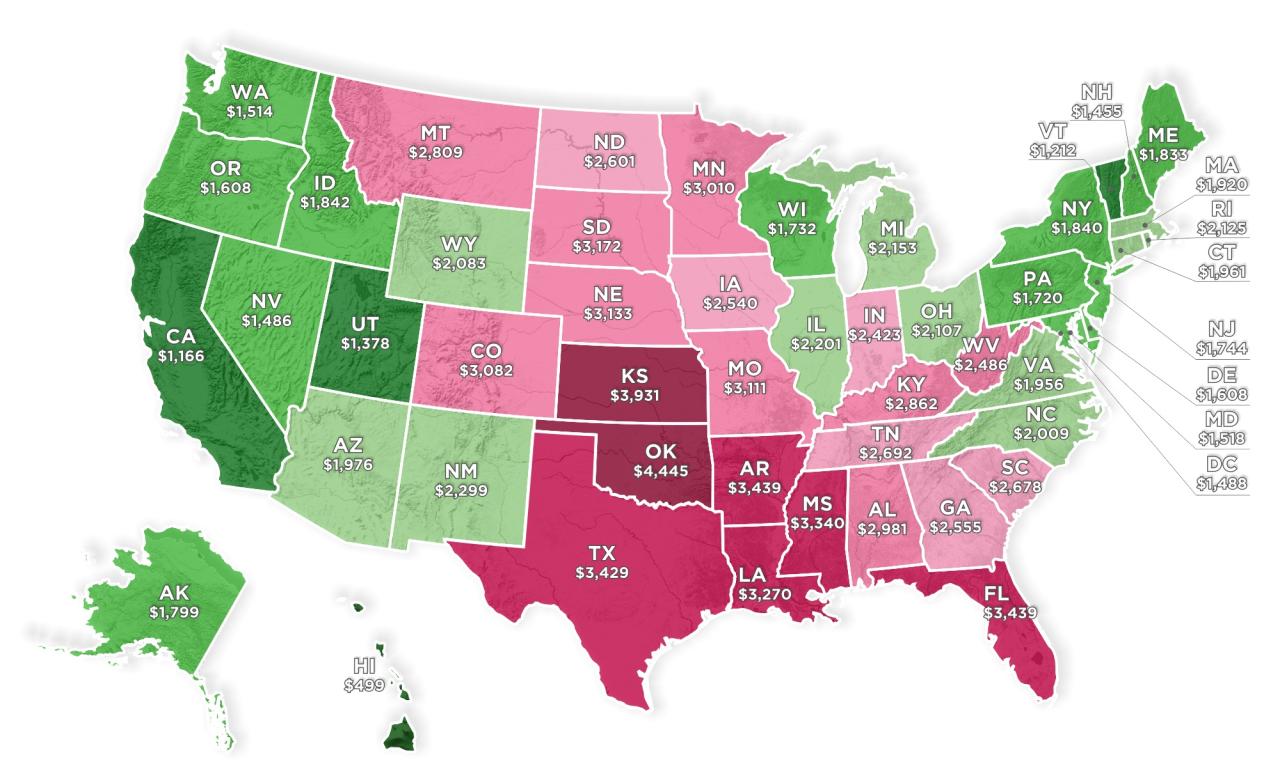In today’s economic climate, finding the cheapest insurance rates is a priority for many individuals and families. Navigating the complex world of insurance premiums can feel daunting, but understanding the factors that influence costs and leveraging available strategies can significantly impact your bottom line. This guide will equip you with the knowledge and tools to secure affordable coverage without compromising on essential protection. From identifying key factors that determine individual premiums to uncovering hidden discounts and maximizing savings opportunities, we’ll explore a comprehensive approach to securing the most favorable insurance rates. By understanding the intricacies of insurance pricing and leveraging effective strategies, you can confidently navigate the insurance landscape and achieve significant financial benefits. Understanding Insurance Rates Insurance rates are a crucial aspect of financial planning, as they determine the cost of coverage for various risks. Understanding the factors that influence these rates and the different types of insurance policies available can help individuals make informed decisions about their insurance needs. Factors Influencing Insurance Rates Several factors play a significant role in determining insurance rates. These factors are assessed by insurance companies to evaluate the risk associated with insuring an individual or property. Age: Insurance rates generally increase with age for certain types of coverage, such as health insurance, as the likelihood of health issues tends to rise with age. However, for other types of insurance, such as life insurance, younger individuals may have higher premiums due to a higher risk of premature death. Location: Geographic location significantly influences insurance rates. Areas with higher crime rates, natural disaster risks, or traffic congestion may have higher insurance premiums. For example, homeowners insurance in hurricane-prone regions is typically more expensive than in areas with minimal risk of natural disasters. Driving History: For auto insurance, driving history is a key factor in determining rates. Drivers with a clean record and no accidents or traffic violations typically receive lower premiums than those with a history of accidents or violations. Insurance companies often use a points system to assess driving history, with more points indicating a higher risk. Credit Score: Credit score can impact insurance rates, particularly for auto and homeowners insurance. A good credit score generally signifies responsible financial behavior, which insurance companies may associate with lower risk. Conversely, a poor credit score may lead to higher premiums. Coverage Amount: The amount of coverage selected for a policy can influence rates. Higher coverage amounts generally translate to higher premiums. For instance, choosing a higher deductible for auto insurance can result in lower premiums, but it also means you will have to pay more out of pocket if you need to file a claim. Policy Type: Different types of insurance policies have varying rates depending on the coverage provided. For example, comprehensive auto insurance typically has higher premiums than liability-only coverage, as it provides more extensive protection. Similarly, term life insurance policies generally have lower premiums than whole life insurance policies, as they offer coverage for a specific period. Types of Insurance Policies and Rates Insurance policies can be categorized based on the type of coverage they provide. Each type of policy has its own set of factors that influence rates. Health Insurance: Health insurance premiums vary based on factors such as age, health status, location, and coverage plan. For example, a young and healthy individual may qualify for a lower premium compared to an older individual with pre-existing health conditions. Auto Insurance: Auto insurance rates are influenced by factors such as driving history, vehicle type, location, and coverage level. Drivers with a history of accidents or violations may face higher premiums than those with a clean record. The type of vehicle, such as a sports car, may also result in higher premiums due to a higher risk of accidents. Homeowners Insurance: Homeowners insurance premiums are determined by factors such as the value of the property, location, age of the home, and coverage level. Homes in high-risk areas, such as those prone to natural disasters, may have higher premiums. The coverage amount chosen for the policy, such as the amount of coverage for dwelling and personal property, also influences rates. Life Insurance: Life insurance premiums vary based on age, health status, coverage amount, and policy type. Younger and healthier individuals typically qualify for lower premiums compared to older individuals with health issues. Term life insurance policies generally have lower premiums than whole life insurance policies, as they offer coverage for a specific period. Common Insurance Premiums and Variations Insurance premiums are typically calculated on a monthly or annual basis. The premium amount reflects the risk associated with insuring the individual or property. Here are some examples of common insurance premiums and their variations: Health Insurance: Health insurance premiums can range from a few hundred dollars per month to over a thousand dollars, depending on the factors mentioned above. For example, a young and healthy individual may pay around $200 per month for a basic health insurance plan, while an older individual with pre-existing health conditions may pay over $1,000 per month for a comprehensive plan. Auto Insurance: Auto insurance premiums can vary significantly based on factors such as driving history, vehicle type, and coverage level. A driver with a clean record and a basic liability-only policy may pay around $50 per month, while a driver with a history of accidents and comprehensive coverage may pay over $200 per month. Homeowners Insurance: Homeowners insurance premiums can range from a few hundred dollars per year to several thousand dollars, depending on factors such as the value of the property, location, and coverage level. A homeowner with a modest house in a low-risk area may pay around $500 per year, while a homeowner with a luxury home in a high-risk area may pay over $5,000 per year. Life Insurance: Life insurance premiums can vary widely based on factors such as age, health status, coverage amount, and policy type. A young and healthy individual may pay around $20 per month for a $100,000 term life insurance policy, while an older individual with health issues may pay over $100 per month for a similar policy. Finding the Cheapest Insurance Rates Securing the most affordable insurance rates requires a strategic approach. It involves comparing quotes from multiple providers, utilizing online comparison websites, and even negotiating premiums directly with insurers. Comparing Insurance Quotes Comparing quotes from different insurance providers is crucial for finding the best rates. This process involves gathering information from various insurers, including their coverage options, premiums, and any discounts they offer. Start by contacting several insurance companies directly, either through their websites or by phone. Provide them with your personal information, including your driving history, vehicle details, and desired coverage levels. Request quotes from at least three to five insurers to ensure a comprehensive comparison. Carefully review each quote, paying close attention to the coverage details, deductibles, and premiums. Compare the quotes side-by-side to identify the most affordable options that meet your needs. Benefits of Online Insurance Comparison Websites Online insurance comparison websites simplify the process of finding the cheapest rates. These platforms allow you to enter your information once and receive quotes from multiple insurers simultaneously. Convenience: Online comparison websites eliminate the need to contact each insurer individually, saving you time and effort. Transparency: They provide a clear and concise comparison of quotes from various providers, making it easier to identify the best deals. Competition: The presence of multiple insurers on these platforms fosters competition, potentially leading to lower premiums. Customization: Many websites allow you to customize your search by specifying your coverage needs, vehicle details, and other factors, ensuring you receive relevant quotes. Negotiating Insurance Premiums Negotiating with insurance companies can potentially lower your premiums. While insurers may not always be willing to negotiate, it’s worth trying, especially if you have a good driving record and have been a loyal customer. Review your driving history: A clean driving record can be a strong bargaining chip. If you have no accidents or violations, emphasize this to the insurer. Consider increasing your deductible: A higher deductible can translate to lower premiums. Evaluate if you can afford a higher deductible in case of an accident. Bundle your policies: Combining multiple insurance policies, such as auto and home insurance, with the same insurer can often lead to discounts. Shop around: Even after you’ve received quotes, it’s beneficial to continue comparing rates from other insurers to ensure you’re getting the best deal. Be polite and persistent: When negotiating, maintain a professional and respectful tone. Be prepared to explain your reasons for wanting a lower premium and be persistent in your request. Factors Affecting Insurance Costs Insurance premiums are not one-size-fits-all. Several factors influence how much you pay for your insurance. Understanding these factors can help you make informed decisions to potentially lower your premiums. Driving History Your driving history is a major factor in determining your insurance rates. Insurance companies assess your risk based on your past driving behavior. Accidents: A history of accidents, especially those resulting in claims, will significantly increase your premiums. Insurance companies view this as a higher risk of future claims. Traffic Violations: Speeding tickets, reckless driving citations, and DUI convictions can all lead to higher premiums. These violations indicate a higher risk of accidents and claims. Driving Record Cleanliness: Maintaining a clean driving record with no accidents or violations is crucial for lower premiums. This demonstrates a lower risk profile to insurers. Credit Score While it may seem counterintuitive, your credit score can also impact your insurance premiums. … Read more




